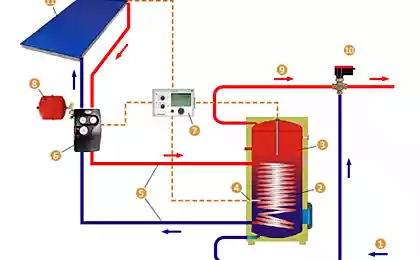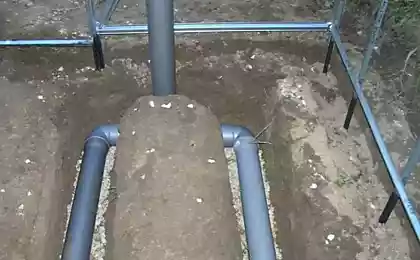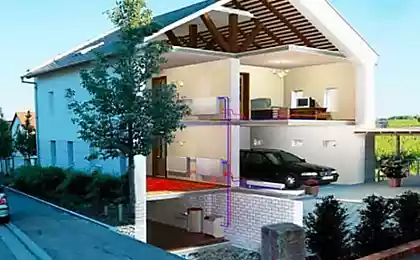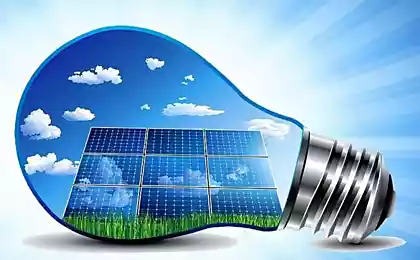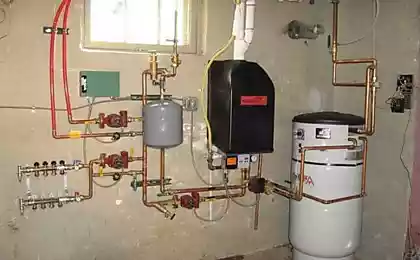782
Solar heating of private homes: options and circuit device
Most of the year we have to spend money on heating their homes. In this situation, any help would be useful. Energy from the sun suitable for this purpose is the best: absolutely clean and free. Modern technologies allow solar heating of private homes not only in the southern regions, but in Central.
What can you offer modern technology, on average, 1 m2 of the earth's surface receives 161 watts of solar energy per hour. Of course, at the equator, the figure will be many times higher than in the Arctic. In addition, the density of solar radiation depends on time of year. In Moscow region the intensity of solar radiation in December-January, is different from may-July, more than five times. However, modern systems are so effective that they are able to work almost everywhere on earth.

Modern solar systems able to work efficiently in overcast and cold weather down to -30°C the use of energy solar radiation with maximum efficiency is solved in two ways: direct heating in the thermal collectors and solar photovoltaic panels.
First solar panels convert the energy of sunlight into electricity, then transmitted through a special system users, such as boiler.
Thermal collectors heated by the solar rays heats the coolant heating systems and hot water.
Thermal collectors come in several forms, including open and closed systems of flat and spherical design, a hemispherical collectors concentrators and many other options.
The thermal energy obtained from solar collectors is used to heat hot water or coolant heating system.
Despite clear progress in the development of solutions for collecting, accumulation and use of solar energy, there are advantages and disadvantages.
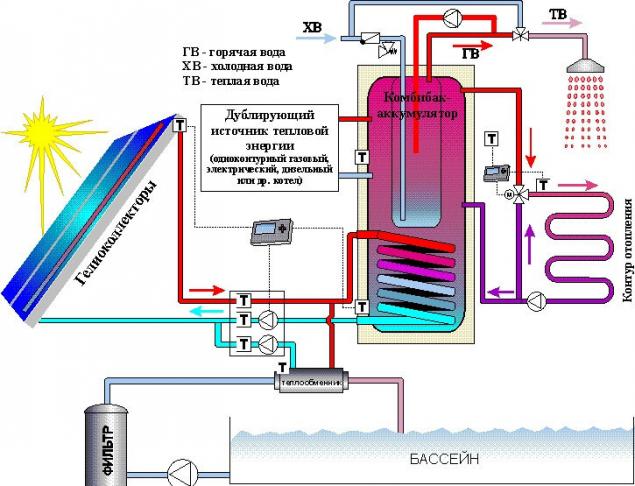
The efficiency of solar heating in our latitudes is quite low, due to insufficient number of Sunny days for the regular operation of the systemthe Pros and cons of solar energythe Most obvious advantage of using solar energy is its accessibility. In fact, even in the gloomy and cloudy weather solar energy can be collected and used.
The second advantage is zero emissions. In fact, it is the most environmentally friendly and natural form of energy. Solar panels and collectors do not produce noise. In most cases, installed on the roofs of buildings, maximizing the area a suburban area.
The disadvantages associated with the use of solar energy lies in the impermanence of light. In the dark is nothing to collect, the situation is compounded by the fact that the peak of the heating season falls on the shortest daylight day of the year.
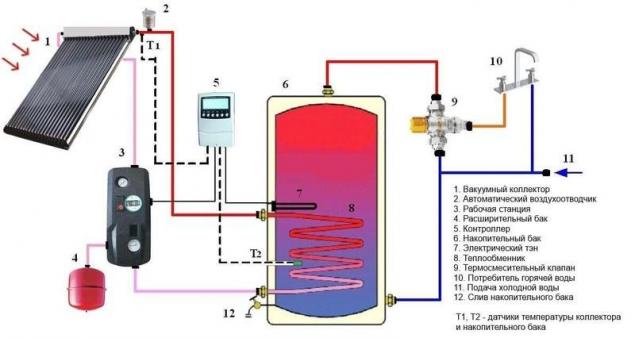
A significant disadvantage of heating based on the use of solar collectors is the lack of the ability to accumulate thermal energy. The scheme includes only the expansion tank is Necessary to monitor the optical purity of the panels, a slight contamination drastically reduces efficiency.
In addition, we cannot say that the operation of the system on solar energy costs is completely free, there are fixed costs for depreciation of equipment, the circulation pump and control electronics.
Open solar collectorOpen solar collector is a unprotected from external influences, the system of tubes, which circulates heated directly by the sun the coolant. As the coolant used water, gas, air, antifreeze. Tubes or fixed on the carrier panel in the form of a coil or joined in parallel rows to the output nozzle.
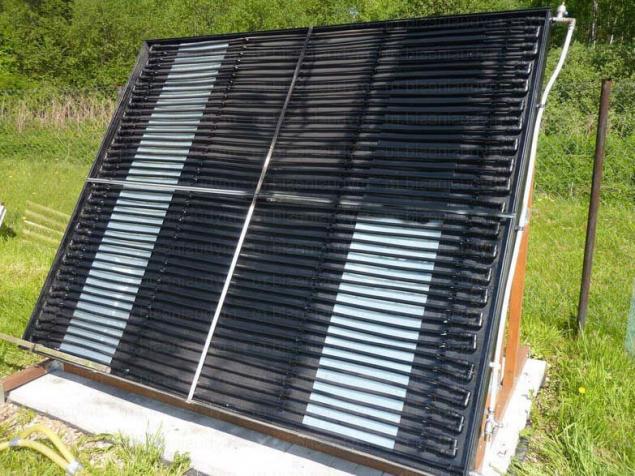
Solar collectors of an open type not able to cope with the heating of private homes. Due to the lack of insulation, the heat carrier cools down quickly. They are used in the summer mainly for water heating in showers or pools Have open collectors there is generally no exclusion. The design is very simple, so has low cost and is often made independently.
Due to the lack of insulation is almost not preserve derived from solar energy have low efficiency. Used them mostly in the summer for heating water in swimming pools or summer showers. Set in Sunny and warm regions with small changes in temperature of the ambient air and heated water. Work well only in Sunny, calm weather.
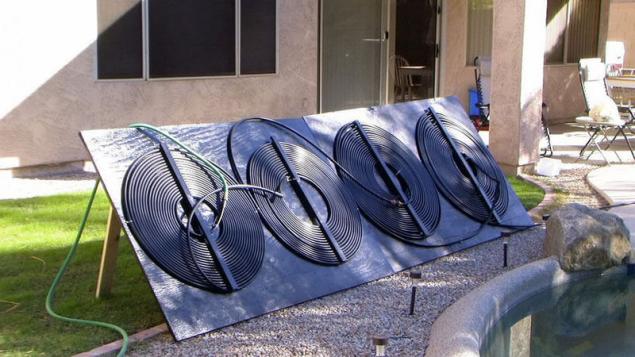
The simplest solar collector with a heat sink made from a Bay of plastic pipes, will ensure the supply of heated water in the country for irrigation and domestic useTubular solar collectors withTubular solar collectors are made up of separate tubes through which runs water, gas or steam. This is one of the varieties of solar power systems of open type. However, the coolant is already much better protected against external negativity. Particularly in vacuum systems, arranged on the principle of thermos.
Each tube is connected to the system separately, parallel to each other. In case of failure of one tube, it is easy to change to a new one. The whole structure can be collected directly on the roof of the building, which greatly simplifies installation.
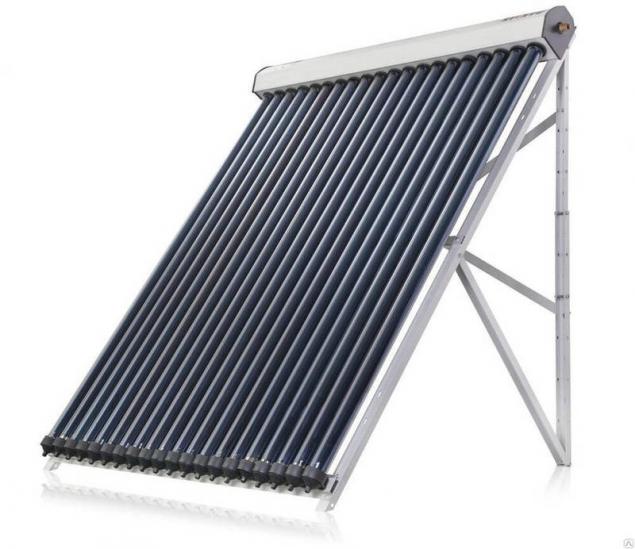
The tubular manifold has a modular structure. The main element is a vacuum tube, number of tubes varies from 18 to 30, allowing you to accurately choose the right power system is a Strong plus tubular solar collector is the cylindrical form of the main elements through which solar radiation is captured round daylight without the use of expensive tracking systems for the movement of the sun.
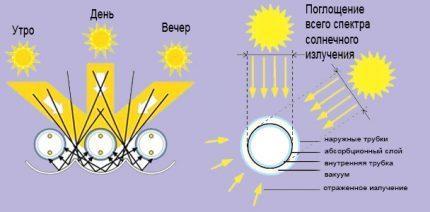
Special multi-layer coating creates a kind of optical trap for the solar rays. The diagram shows parts of the outer wall of the vacuum bulb reflecting rays on the wall of the inner bulb According to the construction of tubes distinguish pen and coaxial solar collectors.
A coaxial pipe is a vessel of Daura or the familiar thermos. Made of two tubes between which air is pumped out. On the inner surface of the inner bulb applied highly selective coating to efficiently absorb solar energy.
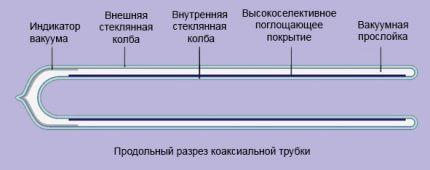
When the cylindrical form of tube the sun's rays always fall perpendicularly to the surface of the Thermal energy from the inner selective layer is transferred to a heat pipe or a heat exchanger made of aluminium plates. At this stage, the unwanted heat loss.
The pen tube is a glass cylinder with the inserted inside the pen absorber.
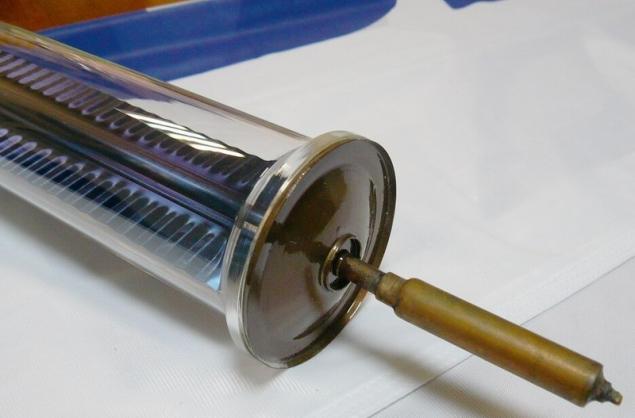
The name of the system received from the pen of the absorber, which tightly hugs a heat channel thermally conductive metal For good thermal insulation of the tube air is pumped out. The heat transfer from the absorber occurs without losses, so the efficiency of the pen tubes above.
According to the method of heat transfer there are two systems: uniflow and termokraskoy (heat pipe).
Thermochrome is a sealed container with a volatile liquid.
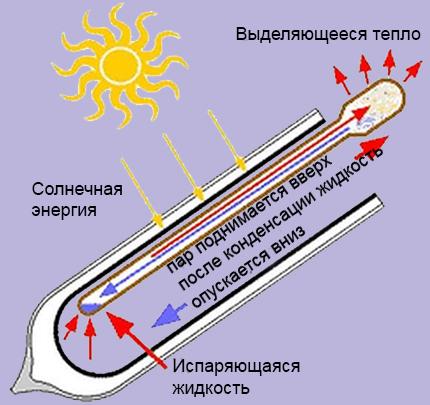
Because volatile liquid naturally flows down to the bottom thermotrace, the minimum angle is 20° Inside thermotrace is a volatile liquid, which takes heat from the inner wall of the bulb or from the pen of the absorber. Under the influence of temperature the liquid boils and the vapour rises. After the heat given to the coolant heating or hot water, steam condenseries into liquid and flows downward.
As the volatile liquid is often used water at low pressure.
In flow-through system is used, the U-shaped tube, through which circulates water or coolant heating system.
One half of the U-shaped tube is designed for cold coolant, the second blows the heated. When heated, the coolant expands and flows to the storage tank, providing a natural circulation. As in the case of systems with termokraskoy, the minimum angle should be at least 20⁰.
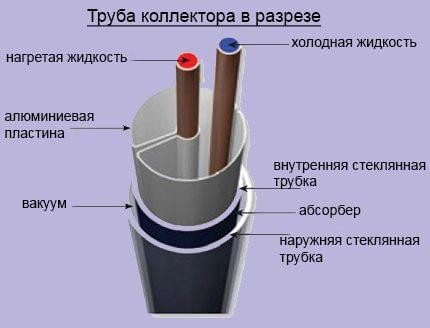
When straight-through connecting the system pressure may not be high, because inside the bulb technical vacuum Flow systems are more efficient, so they heat the coolant.
If solar collector systems are planned for use all year round, then they pumped a special antifreeze.
Advantages and disadvantages of tube collectorsUse tube solar collectors has a number of advantages and disadvantages. The design of the tubular solar collector is composed of identical elements, which are relatively easy to replace.
Advantages:
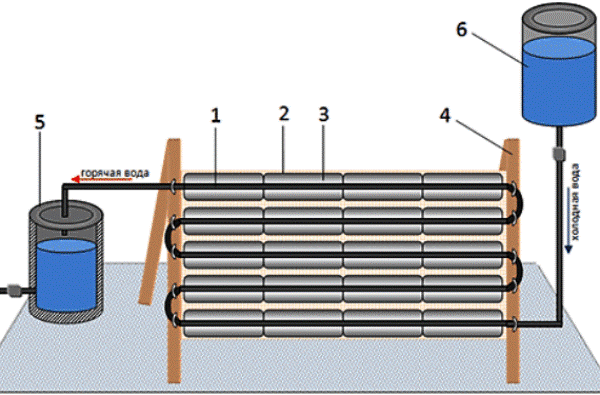
Tubular manifolds are solar systems open, therefore are not suitable for year-round use in heating systemsclosed Flat solar collectorsa Flat-plate collector consists of an aluminum frame, special absorbing layer – absorber, transparent cover, piping and insulation.
As the absorber used blackened copper plates, wherein are ideal for solar thermal. When absorption of solar energy absorber is a transfer of received solar energy to the coolant circulating in the adjacent to the absorber tubing.
On the outer side of the closed panel protected by a transparent coating. It is made of impact-resistant tempered glass, which has a bandwidth of 0.4-1.8 µm. This range has a maximum of solar radiation. Shockproof glass is a good protection from hail. From the back side of the entire panel securely insulated.

Flat solar collectors have the highest performance and simple design. Their efficiency is increased due to the application of the absorber. They are able to capture diffuse and direct solar radiation on the list of advantages of the closed flat panels include:
The disadvantages include:
Comparison of the characteristics of solar collectors, the Most important indicator of the solar collector is efficiency. Useful performance of different designs of solar collectors depends on the temperature difference. While flat-plate collectors is much cheaper than tubular.
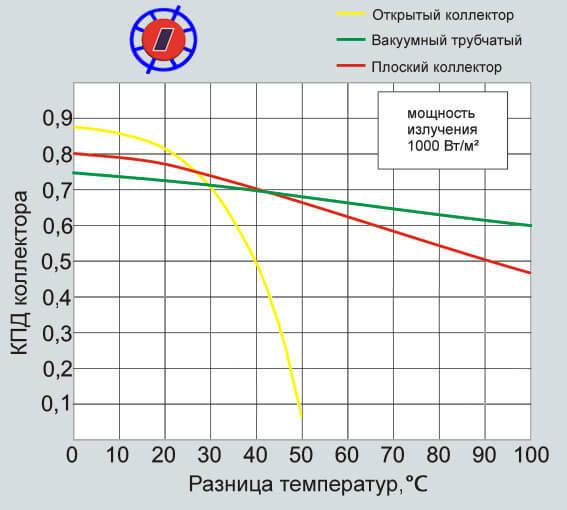
The values of efficiency depend on the quality of manufacture of the solar collector. The purpose of the chart to show the effectiveness of using different systems depending on the temperature difference When choosing a solar collector should pay attention to the number of parameters showing the efficiency and capacity of the device.
For solar collectors there are a few important characteristics:
Methods of connection to the heating systemSince solar energy cannot provide stable and round-the-clock supply of energy required by the system resistant to these drawbacks.
For an average strip of Russia solar devices cannot guarantee the stable supply of energy, are therefore used as additional system. Integration into existing heating and hot water is different for solar collector and solar panels.
Scheme of the connection of the heat reservoirdepending on the purpose of use of thermal collector used different systems connect. Options may be several:
Summer for hot water supply, Winter heating and hot water Summer option is the most simple and can do even without a circulation pump, using the natural circulation of water.
The water is heated in the solar collector and the thermal expansion flows into the storage tank or boiler. Thus there is a natural circulation: in place of hot water from the tank is sucked cold.
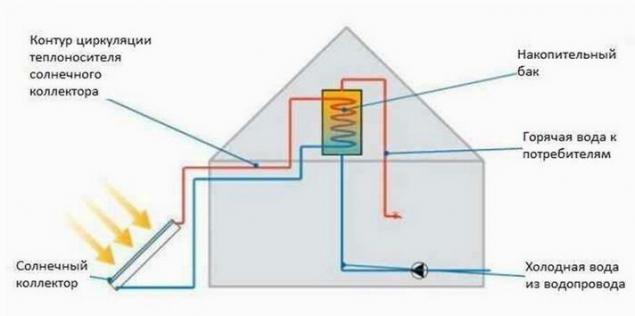
In winter in low temperature direct heating of water is not possible. In closed loop circulates a special coolant providing the heat transfer from the collector to the heat exchanger in the tank As any system based on natural circulation is not very efficient, requiring compliance with the required slope. In addition, the storage tank must be higher than the solar collector.
That the water stayed hot for as long as possible, the tank should be thoroughly warmed.
If You really want to achieve the most efficient operation of the solar collector, wiring diagram more complicated.
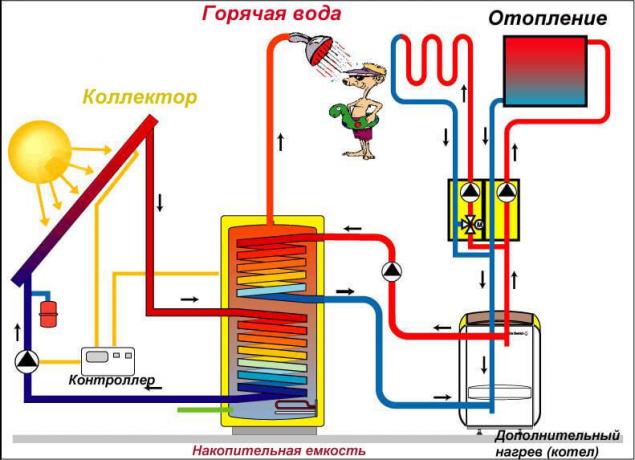
That night, the collector does not become a heat sink it is necessary to stop the circulation of water forced By the system of the solar collector circulates non-freezing heat carrier. Forced circulation ensures the pump under control of the controller.
The controller controls the circulation pump based on the testimony of at least two temperature sensors. The first sensor measures the temperature in the storage tank, the second to the feed tube of the hot heat carrier of the solar collector. As soon as the temperature in the tank exceeds the temperature of the heat carrier in the collector, the controller turns off the circulation pump, stopping the circulation of coolant through the system.
In turn, when the temperature in the storage tank is below preset switches on the boiler.
Wiring diagram solar panelsIt would be tempting to apply a similar scheme of connection of solar panels to the grid, as implemented in the case of a solar collector, accumulating received per day energy. Unfortunately for the power supply system of a private house to create a battery pack with sufficient capacity is very expensive. Therefore, the connection scheme is as follows.
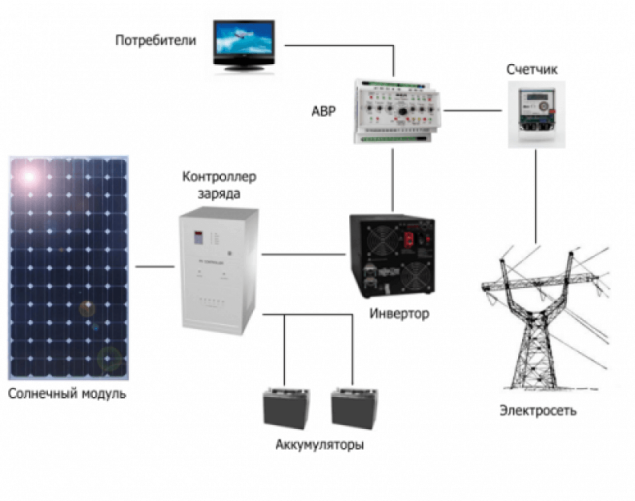
At lower power the electric current from the solar panel block ATS (automatic switch) connects the consumers to the total eletricity With solar panels the charge supplied to the charge controller which serves several functions: provides a constant charging the battery and stabilize the voltage. Further, the electric current supplied to the inverter where it is converted DC 12V or 24V to AC single phase 220V.
Alas, our mains were not designed for energy can work in only one direction from source to consumer. For this reason, you will not be able to sell the produced electricity, or at least make a counter spin in the opposite direction.
The use of solar battery is advantageous in that they provide a more versatile form of energy, but it can not compare in efficiency with solar collectors. However, the latter do not have the ability to store energy in contrast to solar PV panels.
How to calculate the required capacity of the reservoirWhen calculating the required capacity of the solar collector is very often mistakenly perform calculations on the basis of the incoming solar energy during the coldest months of the year.
The fact that the rest of the year the entire system will constantly overheat. The temperature of the coolant in the summer at the outlet of the solar collector can reach 200°C at a heating steam or gas, 120°C, antifreeze, 150°With water. If the coolant boils, it is partially to evaporate. As a result of its need to be replaced.
Manufacturers recommend to proceed from these numbers:
The power generated by one tube of the vacuum system depends on the geographical location. The rate of solar energy falling per year per 1 m2 of the earth is called insolation. Knowing the length and diameter of the tube you can calculate the aperture – the effective absorption area. It remains to apply the coefficients of absorption and emission to calculate the power of one handset per year.
Example of calculation:
Standard tube length is 1800mm, the effective — 1600 mm, Diameter 58 mm. Aperture – the shaded area created by the pipe. Thus the area of the rectangle shade is:
S = 1,6 * 0,058 = 0,0928м2
The average efficiency of the tube is 80%, the solar insolation for Moscow is around 1170 kWh/m2 per year. Thus one tube will produce in the year:
W = 0,0928 * 1170 * 0,8 = 86,86 kWh
It should be noted that this is a very rough calculation. The amount of energy produced depends on the orientation of the installation angle, average temperature, etc. published
Source: sovet-ingenera.com/eco-energy/eko-dom/solnechnoe-otoplenie-chastnogo-doma.html
What can you offer modern technology, on average, 1 m2 of the earth's surface receives 161 watts of solar energy per hour. Of course, at the equator, the figure will be many times higher than in the Arctic. In addition, the density of solar radiation depends on time of year. In Moscow region the intensity of solar radiation in December-January, is different from may-July, more than five times. However, modern systems are so effective that they are able to work almost everywhere on earth.

Modern solar systems able to work efficiently in overcast and cold weather down to -30°C the use of energy solar radiation with maximum efficiency is solved in two ways: direct heating in the thermal collectors and solar photovoltaic panels.
First solar panels convert the energy of sunlight into electricity, then transmitted through a special system users, such as boiler.
Thermal collectors heated by the solar rays heats the coolant heating systems and hot water.
Thermal collectors come in several forms, including open and closed systems of flat and spherical design, a hemispherical collectors concentrators and many other options.
The thermal energy obtained from solar collectors is used to heat hot water or coolant heating system.
Despite clear progress in the development of solutions for collecting, accumulation and use of solar energy, there are advantages and disadvantages.

The efficiency of solar heating in our latitudes is quite low, due to insufficient number of Sunny days for the regular operation of the systemthe Pros and cons of solar energythe Most obvious advantage of using solar energy is its accessibility. In fact, even in the gloomy and cloudy weather solar energy can be collected and used.
The second advantage is zero emissions. In fact, it is the most environmentally friendly and natural form of energy. Solar panels and collectors do not produce noise. In most cases, installed on the roofs of buildings, maximizing the area a suburban area.
The disadvantages associated with the use of solar energy lies in the impermanence of light. In the dark is nothing to collect, the situation is compounded by the fact that the peak of the heating season falls on the shortest daylight day of the year.

A significant disadvantage of heating based on the use of solar collectors is the lack of the ability to accumulate thermal energy. The scheme includes only the expansion tank is Necessary to monitor the optical purity of the panels, a slight contamination drastically reduces efficiency.
In addition, we cannot say that the operation of the system on solar energy costs is completely free, there are fixed costs for depreciation of equipment, the circulation pump and control electronics.
Open solar collectorOpen solar collector is a unprotected from external influences, the system of tubes, which circulates heated directly by the sun the coolant. As the coolant used water, gas, air, antifreeze. Tubes or fixed on the carrier panel in the form of a coil or joined in parallel rows to the output nozzle.

Solar collectors of an open type not able to cope with the heating of private homes. Due to the lack of insulation, the heat carrier cools down quickly. They are used in the summer mainly for water heating in showers or pools Have open collectors there is generally no exclusion. The design is very simple, so has low cost and is often made independently.
Due to the lack of insulation is almost not preserve derived from solar energy have low efficiency. Used them mostly in the summer for heating water in swimming pools or summer showers. Set in Sunny and warm regions with small changes in temperature of the ambient air and heated water. Work well only in Sunny, calm weather.

The simplest solar collector with a heat sink made from a Bay of plastic pipes, will ensure the supply of heated water in the country for irrigation and domestic useTubular solar collectors withTubular solar collectors are made up of separate tubes through which runs water, gas or steam. This is one of the varieties of solar power systems of open type. However, the coolant is already much better protected against external negativity. Particularly in vacuum systems, arranged on the principle of thermos.
Each tube is connected to the system separately, parallel to each other. In case of failure of one tube, it is easy to change to a new one. The whole structure can be collected directly on the roof of the building, which greatly simplifies installation.

The tubular manifold has a modular structure. The main element is a vacuum tube, number of tubes varies from 18 to 30, allowing you to accurately choose the right power system is a Strong plus tubular solar collector is the cylindrical form of the main elements through which solar radiation is captured round daylight without the use of expensive tracking systems for the movement of the sun.

Special multi-layer coating creates a kind of optical trap for the solar rays. The diagram shows parts of the outer wall of the vacuum bulb reflecting rays on the wall of the inner bulb According to the construction of tubes distinguish pen and coaxial solar collectors.
A coaxial pipe is a vessel of Daura or the familiar thermos. Made of two tubes between which air is pumped out. On the inner surface of the inner bulb applied highly selective coating to efficiently absorb solar energy.

When the cylindrical form of tube the sun's rays always fall perpendicularly to the surface of the Thermal energy from the inner selective layer is transferred to a heat pipe or a heat exchanger made of aluminium plates. At this stage, the unwanted heat loss.
The pen tube is a glass cylinder with the inserted inside the pen absorber.

The name of the system received from the pen of the absorber, which tightly hugs a heat channel thermally conductive metal For good thermal insulation of the tube air is pumped out. The heat transfer from the absorber occurs without losses, so the efficiency of the pen tubes above.
According to the method of heat transfer there are two systems: uniflow and termokraskoy (heat pipe).
Thermochrome is a sealed container with a volatile liquid.

Because volatile liquid naturally flows down to the bottom thermotrace, the minimum angle is 20° Inside thermotrace is a volatile liquid, which takes heat from the inner wall of the bulb or from the pen of the absorber. Under the influence of temperature the liquid boils and the vapour rises. After the heat given to the coolant heating or hot water, steam condenseries into liquid and flows downward.
As the volatile liquid is often used water at low pressure.
In flow-through system is used, the U-shaped tube, through which circulates water or coolant heating system.
One half of the U-shaped tube is designed for cold coolant, the second blows the heated. When heated, the coolant expands and flows to the storage tank, providing a natural circulation. As in the case of systems with termokraskoy, the minimum angle should be at least 20⁰.

When straight-through connecting the system pressure may not be high, because inside the bulb technical vacuum Flow systems are more efficient, so they heat the coolant.
If solar collector systems are planned for use all year round, then they pumped a special antifreeze.
Advantages and disadvantages of tube collectorsUse tube solar collectors has a number of advantages and disadvantages. The design of the tubular solar collector is composed of identical elements, which are relatively easy to replace.
Advantages:
- low heat loss;
- the ability to operate at temperatures up to -30⁰С;
- effective performance in the light throughout the day;
- good performance in temperate and cold climates;
- low windage, a reasonable ability of the tubular system to pass through the air mass;
- the possibility of producing high temperatures.
- not capable of self-cleaning from snow, ice, frost;
- high cost.

Tubular manifolds are solar systems open, therefore are not suitable for year-round use in heating systemsclosed Flat solar collectorsa Flat-plate collector consists of an aluminum frame, special absorbing layer – absorber, transparent cover, piping and insulation.
As the absorber used blackened copper plates, wherein are ideal for solar thermal. When absorption of solar energy absorber is a transfer of received solar energy to the coolant circulating in the adjacent to the absorber tubing.
On the outer side of the closed panel protected by a transparent coating. It is made of impact-resistant tempered glass, which has a bandwidth of 0.4-1.8 µm. This range has a maximum of solar radiation. Shockproof glass is a good protection from hail. From the back side of the entire panel securely insulated.

Flat solar collectors have the highest performance and simple design. Their efficiency is increased due to the application of the absorber. They are able to capture diffuse and direct solar radiation on the list of advantages of the closed flat panels include:
- the simplicity of the design;
- good performance in the regions with a warm climate;
- the ability to install at any angle in the presence of devices for changing the angle of inclination;
- the ability to self-clean from snow and frost;
- low price.
The disadvantages include:
- high heat loss;
- a lot of weight;
- high windage when placing the panels at an angle to the horizontal;
- limitations in performance when temperature changes more than 40°C.
Comparison of the characteristics of solar collectors, the Most important indicator of the solar collector is efficiency. Useful performance of different designs of solar collectors depends on the temperature difference. While flat-plate collectors is much cheaper than tubular.

The values of efficiency depend on the quality of manufacture of the solar collector. The purpose of the chart to show the effectiveness of using different systems depending on the temperature difference When choosing a solar collector should pay attention to the number of parameters showing the efficiency and capacity of the device.
For solar collectors there are a few important characteristics:
- adsorption ratio – shows the ratio of absorbed energy to the total;
- the emission factor shows the ratio of transmitted energy to absorbed;
- General aperture area;
- Efficiency.
Methods of connection to the heating systemSince solar energy cannot provide stable and round-the-clock supply of energy required by the system resistant to these drawbacks.
For an average strip of Russia solar devices cannot guarantee the stable supply of energy, are therefore used as additional system. Integration into existing heating and hot water is different for solar collector and solar panels.
Scheme of the connection of the heat reservoirdepending on the purpose of use of thermal collector used different systems connect. Options may be several:
Summer for hot water supply, Winter heating and hot water Summer option is the most simple and can do even without a circulation pump, using the natural circulation of water.
The water is heated in the solar collector and the thermal expansion flows into the storage tank or boiler. Thus there is a natural circulation: in place of hot water from the tank is sucked cold.

In winter in low temperature direct heating of water is not possible. In closed loop circulates a special coolant providing the heat transfer from the collector to the heat exchanger in the tank As any system based on natural circulation is not very efficient, requiring compliance with the required slope. In addition, the storage tank must be higher than the solar collector.
That the water stayed hot for as long as possible, the tank should be thoroughly warmed.
If You really want to achieve the most efficient operation of the solar collector, wiring diagram more complicated.

That night, the collector does not become a heat sink it is necessary to stop the circulation of water forced By the system of the solar collector circulates non-freezing heat carrier. Forced circulation ensures the pump under control of the controller.
The controller controls the circulation pump based on the testimony of at least two temperature sensors. The first sensor measures the temperature in the storage tank, the second to the feed tube of the hot heat carrier of the solar collector. As soon as the temperature in the tank exceeds the temperature of the heat carrier in the collector, the controller turns off the circulation pump, stopping the circulation of coolant through the system.
In turn, when the temperature in the storage tank is below preset switches on the boiler.
Wiring diagram solar panelsIt would be tempting to apply a similar scheme of connection of solar panels to the grid, as implemented in the case of a solar collector, accumulating received per day energy. Unfortunately for the power supply system of a private house to create a battery pack with sufficient capacity is very expensive. Therefore, the connection scheme is as follows.

At lower power the electric current from the solar panel block ATS (automatic switch) connects the consumers to the total eletricity With solar panels the charge supplied to the charge controller which serves several functions: provides a constant charging the battery and stabilize the voltage. Further, the electric current supplied to the inverter where it is converted DC 12V or 24V to AC single phase 220V.
Alas, our mains were not designed for energy can work in only one direction from source to consumer. For this reason, you will not be able to sell the produced electricity, or at least make a counter spin in the opposite direction.
The use of solar battery is advantageous in that they provide a more versatile form of energy, but it can not compare in efficiency with solar collectors. However, the latter do not have the ability to store energy in contrast to solar PV panels.
How to calculate the required capacity of the reservoirWhen calculating the required capacity of the solar collector is very often mistakenly perform calculations on the basis of the incoming solar energy during the coldest months of the year.
The fact that the rest of the year the entire system will constantly overheat. The temperature of the coolant in the summer at the outlet of the solar collector can reach 200°C at a heating steam or gas, 120°C, antifreeze, 150°With water. If the coolant boils, it is partially to evaporate. As a result of its need to be replaced.
Manufacturers recommend to proceed from these numbers:
- the provision of hot water not more than 70%;
- ensuring heating systems are not more than 30%.
The power generated by one tube of the vacuum system depends on the geographical location. The rate of solar energy falling per year per 1 m2 of the earth is called insolation. Knowing the length and diameter of the tube you can calculate the aperture – the effective absorption area. It remains to apply the coefficients of absorption and emission to calculate the power of one handset per year.
Example of calculation:
Standard tube length is 1800mm, the effective — 1600 mm, Diameter 58 mm. Aperture – the shaded area created by the pipe. Thus the area of the rectangle shade is:
S = 1,6 * 0,058 = 0,0928м2
The average efficiency of the tube is 80%, the solar insolation for Moscow is around 1170 kWh/m2 per year. Thus one tube will produce in the year:
W = 0,0928 * 1170 * 0,8 = 86,86 kWh
It should be noted that this is a very rough calculation. The amount of energy produced depends on the orientation of the installation angle, average temperature, etc. published
Source: sovet-ingenera.com/eco-energy/eko-dom/solnechnoe-otoplenie-chastnogo-doma.html
The project of the Russian photographer: forget anonymity!
How to create the grapes in the form of a fan without the trunk


